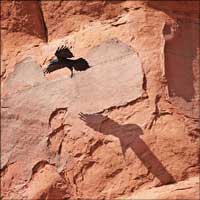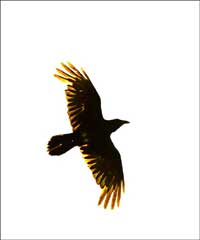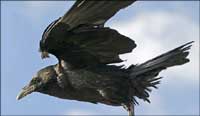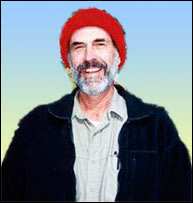![]()
Ravens
by Loren Haury
(please click on pictures for larger versions)
Loren Haury’s poetry and photography appeared in our first Circle of Friends in the fall of 2005. Visit the Archives to view “Getting There,” Loren’s meditation on a walk in the desert through words and images.
From June 1-30, 2006, Loren’s raven photographs appeared at Photography on the Square Gallery in Flagstaff, Arizona. Below, we present Loren’s introduction to his Flagstaff exhibition. No wonder he, a native of Arizona and former Navy pilot, remains fascinated by the savvy, black-feathered masters of aerobatics in the desert sky.
Ravens
by Loren
Haury
 Because
of their size, intelligence, and habits,
ravens have always played a major role
in myth, folklore, art, and literature
as a creator and/or trickster figure, as
well as a bird of wisdom or ill omen. Many
cultures revere ravens, while others fear
and persecute them.
Because
of their size, intelligence, and habits,
ravens have always played a major role
in myth, folklore, art, and literature
as a creator and/or trickster figure, as
well as a bird of wisdom or ill omen. Many
cultures revere ravens, while others fear
and persecute them.
Second only to macaws in intelligence, ravens have a brain mass to body mass ratio similar to that of primates. As John Marzluff writes, "Mentally, crows and ravens are more like flying monkeys than they are like other birds. This means they are able to learn, remember, and use insight to solve natural and human challenges". They use tools to get food or escape cages and practice deceit to protect food caches from theft by other ravens.
 Ravens
are songbirds, but it is their distinctive
calls that are most often heard. Ravens
make more than 80 unique vocalizations,
although individual birds will use fewer.
Regional dialects are common and sex- and
pair-specific calls are known. Ravens can
imitate both the sounds of nature and human
speech.
Ravens
are songbirds, but it is their distinctive
calls that are most often heard. Ravens
make more than 80 unique vocalizations,
although individual birds will use fewer.
Regional dialects are common and sex- and
pair-specific calls are known. Ravens can
imitate both the sounds of nature and human
speech.
Like otters, ravens love to play. They will dig and roll in snow, as well as slide or roll down snowy slopes. Consummate flyers, they carry a stone, twig or bit of food high into the air and drop the object for themselves or others to try to catch before it hits the ground. Highly skilled at aerobatics, they perform barrel rolls, flat spins, brief inverted flight, and precipitous dives with folded wings. The aerial maneuvers are often done in large groups and may be associated with mating rituals, pair bonding, or establishing dominance hierarchies, as well as for play.
 The
photographs in this show are of the Common
Raven (Corvus corax), which occurs in the
western and northern United States and
Canada in all habitats from the lowest
desert to the high arctic. The only other
raven in the U.S., the Chihuahuan Raven
(Corvus cryptoleucus), is restricted to
grass and brush lands of southeastern Arizona,
New Mexico and west Texas. There are eight
other species of ravens, three in Australia
and five in Africa and the Middle East
to Central Asia.
The
photographs in this show are of the Common
Raven (Corvus corax), which occurs in the
western and northern United States and
Canada in all habitats from the lowest
desert to the high arctic. The only other
raven in the U.S., the Chihuahuan Raven
(Corvus cryptoleucus), is restricted to
grass and brush lands of southeastern Arizona,
New Mexico and west Texas. There are eight
other species of ravens, three in Australia
and five in Africa and the Middle East
to Central Asia.
A few (among many) good references and websites:
- Heinrich, B. 1999. Mind of the raven: Investigations and adventures with wolf-birds. Cliff Street Books
- Marzluff, J.M. & T. Angell 2005. In the company of crows and ravens.Yale University Press
- Savage, C. 1995. Bird brains: The intelligence of crows, ravens, magpies, and jays. Sierra Club Books
- American Society of Crows and Ravens: http://www.ascaronline.org
- Wikipedia: http://en.wikipedia.org/wiki/raven
- Ravens in mythology: http://www.ravenfamily.org/nascakiyetl/obs/rav1.htm
 A
native Arizonan, Loren Haury retired to
Sedona from La Jolla, California, in 1999
following a career in biological oceanography.
His interests in cameras and darkroom work
began in childhood, but it wasn't until
1987 that he took up photography seriously
after being inspired by Stephen Trimble's
magnificent book Blessed by Light. Over
the next 17 years, Loren's focus shifted
from 35mm color landscape and natural abstract
images to black-and-white large format
work printed in silver and platinum/palladium.
Recently however, he has embraced the spontaneity
and versatility of working with 35mm digital
cameras and images. This shift was dictated,
in part, by ravens.
A
native Arizonan, Loren Haury retired to
Sedona from La Jolla, California, in 1999
following a career in biological oceanography.
His interests in cameras and darkroom work
began in childhood, but it wasn't until
1987 that he took up photography seriously
after being inspired by Stephen Trimble's
magnificent book Blessed by Light. Over
the next 17 years, Loren's focus shifted
from 35mm color landscape and natural abstract
images to black-and-white large format
work printed in silver and platinum/palladium.
Recently however, he has embraced the spontaneity
and versatility of working with 35mm digital
cameras and images. This shift was dictated,
in part, by ravens.
Haury became interested in photographing ravens after frequently encountering them during hikes in the red rock country surrounding Sedona. As an ex-Navy fighter pilot, his admiration, and envy, were stirred by the raven's love of flying and their consummate aerobatic skills. Photographing the remarkable variety of their activities has become Loren's way of paying homage to this charismatic bird. The need for portability and ease of pointing and focusing made the 35mm format a physical necessity. Discovering that many hundreds of exposures were needed to achieve an acceptable image made digital an economic necessity.
Haury’s photographs have appeared in the Sierra Club Calendar and several magazines and have won awards in exhibitions in Southern California.